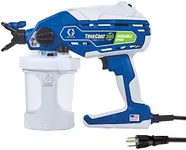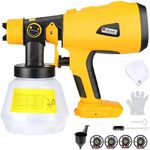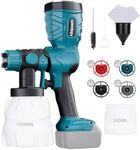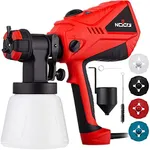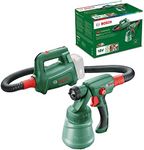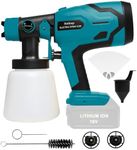Buying Guide for the Best Cordless Airless Paint Sprayer
Choosing the right cordless airless paint sprayer can make your painting projects more efficient and enjoyable. These devices are perfect for both DIY enthusiasts and professionals who need the flexibility to move around without being tethered to a power outlet. When selecting a cordless airless paint sprayer, it's important to consider several key specifications that will impact the performance and suitability of the sprayer for your specific needs. Understanding these specifications will help you make an informed decision and ensure that you choose a sprayer that meets your requirements.Battery LifeBattery life is crucial for cordless airless paint sprayers as it determines how long you can use the sprayer before needing to recharge. A longer battery life is beneficial for larger projects or when working in areas without easy access to power. Battery life can vary significantly, with some sprayers offering only 30 minutes of use, while others can last several hours. Consider the size of your projects and how often you plan to use the sprayer. If you have large or frequent projects, opt for a sprayer with a longer battery life or consider purchasing additional batteries.
Pressure RatingThe pressure rating of a paint sprayer indicates the force with which the paint is expelled from the nozzle. Higher pressure ratings allow for faster application and better coverage, especially on larger surfaces. Pressure ratings typically range from 1000 to 3000 PSI (pounds per square inch). For small to medium projects or detailed work, a lower pressure rating may suffice. However, for large surfaces or thicker paints, a higher pressure rating will be more efficient. Choose a pressure rating that matches the scale and type of your painting projects.
Flow RateFlow rate refers to the amount of paint the sprayer can apply in a given time, usually measured in gallons per minute (GPM). A higher flow rate means faster coverage, which is ideal for large projects. Flow rates can vary from 0.2 to 1.0 GPM. If you are working on small projects or need precision, a lower flow rate may be more appropriate. For extensive or time-sensitive projects, a higher flow rate will help you complete the job more quickly. Consider the size and urgency of your projects when selecting the flow rate.
Weight and PortabilityThe weight and portability of a cordless airless paint sprayer affect how easy it is to handle and maneuver during use. Lighter models are easier to carry and use for extended periods, which is important for projects that require a lot of movement or overhead work. Weights can range from a few pounds to over 20 pounds. If you plan to use the sprayer for long durations or in hard-to-reach areas, opt for a lighter model. For stationary projects, weight may be less of a concern.
Tip Size and CompatibilityThe tip size of a paint sprayer determines the width and thickness of the paint spray pattern. Different tip sizes are suitable for different types of paint and surfaces. Smaller tips are ideal for thin paints and detailed work, while larger tips are better for thicker paints and broad surfaces. Tip sizes are usually measured in thousandths of an inch, such as 0.015 or 0.021. Consider the types of paint you will use and the surfaces you will paint. Ensure the sprayer is compatible with a range of tip sizes to accommodate various projects.



